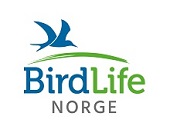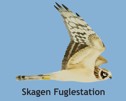
|
|
The gyrfalcon chick being ringed This individual was seen at Kviljo almost eight months later, more than 700 km away from where it hatched. Young gyrfalcon wanders from Jämtland, Sweden, to Lista
By M. Wold Between Christmas and New Year a young gyrfalcon turned up at Kviljo, Lista. It was observed several times hunting for prey in the area and reported as stationary. During an observation on the 9th of January 2013, it was noted that it had a ring on its right leg. The last report of the same bird came a few days later, on the 15th of January. Some weeks after this, on the 3rd of March, we received a message at Lista Bird Observatory that a dead gyrfalcon with a Swedish ring had been found at Skiphaugen. Skiphaugen lies just east of Kviljo and Hanagermona where the bird was seen hunting for prey. It looked like it had been laying there for a few days and was partly devoured by scavengers. The remains of the bird now lie deep frozen at the bird observatory, awaiting closer examination by Agder Nature Museum to see if it is possible to pin point the cause of death. The Ringing Central at Stavanger Museum can inform that the gyrfalcon was ringed as a chick in Jämtland in Sweden on the 4th of July 2012. Hence the Kviljo gyrfalcon died fairly young, but had moved more than 700 km away from its birth place. The bird was ringed by Ulla Falkdalen and Tomas Bergström in Jämtland, they run "Project Jaktfalk" by Ånnsjøns Bird Observatory, a research- and monitoring programme aimed at the Swedish gyrfalcon population in Jämtland. The project has run since 1994 and is a collaboration between the Swedish and the Jämtland Ornithological Society, and it is partly funded by Fylkesmannen i Nord-Trøndelag. The project currently has a webpage under construction. Ulla Falkdalen can tell that the Kviljo gyrfalcon was ringed together with a sibling in the nest, in the western parts of Jämtland. She has sent us some pictures from the ringing of the two chicks, see pictures. The clutch was a late one, probably laid in the beginning of May (normally gyrfalcons lay their eggs during the first half of April). Gyrfalcons do not have any natural predators (except golden eagle, but this happens rarely), so it is possible that the bird at Kviljo either starved if not enough prey was available, or it might have been sick. It was noted by observers that the bird was not as shy as a normal gyrfalcon should be, which might indicate that it was exhausted or sick. The Swedish Ringing Atlas shows that only seven recoveries of Swedish ringed gyrfalcons have been made, see map to the right where the Lista recovery has beed added. Five of the seven recoveries were made in Norway, of which four were along the coast. The recoveries suggest that young, Swedish gyrfalcons move west in autumn and winter, and the newly recovered bird at Skiphaugen in Lista also shows that some move south-west, even as far as to the south of Norway. Gyrfalcon is the largest falcon we have with a wing span of up to 160 cm. It breeds in the mountains, preferably close to the tree line. It preys mainly on willow/rock ptarmigans, and the breeding success depends on the size of the ptarmigan population, a result that "Project Jaktfalk" has shown. It is common that especially young birds wander to the coast in winter where there is better access to prey than in the mountains. Along the coast and the beaches it hunts for sea birds, ducks, gulls and small rodents. Gyrfalcon is seen regularly along the Lista beaches in autumn and winter, but in relatively few numbers. The areas around Steinodden and Havika are often used by wintering gyrfalcons. When they first turn up they can stay for several months. Adult birds are rarely seen along the coast, and are assumed to be stationary in the mountains close to their breeding locations. The Norwegian gyrfalcon population is estimated to 250-385 pairs, and is listed as "near threatened" (NT) on the Norwegian Red List. The size of the Swedish population is smaller, with around 110 pairs, of which 20-30 breed in the Jämtland region. The Swedish population on the corresponding Swedish Red List is classified as "vulnerable" (VU), with a high risk of extinction. Internationally, the gyrfalcon population is not considered threatened however, as it breeds over a large area in the Northern hemisphere, and because it chooses habitats in locations that are not under much pressure from human activity. The gyrfalcon population is however vulnerable to pesticides, and the species was threatened by extinction in the mid-20th century. Less, and more restrictive use of pesticides during later years has contributed to the recent recovery of the population. References: Falkdalen & Bergström, 2012, "Projekt Jaktfalk" i "Fåglar i Jämtland-Härjedalen", årgång 32, 4-2012 Fransson & Petterson, 2001, "Svensk Ringmärkingsatlas", Stockholm Kålås mfl., 2010, "Norsk Rødliste for arter" Ottosson, mfl., 2012, "Fåglarna i Sverige - antal och förekomst", SOF, Halmstad Svensson, Mullarney & Zetterström, 2010, "Gyldendals store fugleguide - Europa og middelhavsområdets fugler i felt" Svorkmo-Lundberg mfl., 2006, "Norsk Vinterfuglatlas. Fuglenes utbredelse, bestandsstørrelse og økologi vinterstid" Wikipedia | |||||||

| Ringing numbers | ||||||||||||
|
| Reportasje fra Lista FS i Aftenposten |

|
| Seasonal deviation | ||||||||||||||||||||||||||||||
|
|
Følg Følg Lista FS på facebook.com |
| Siste 5 på siden |
|
Begynnerkurs i ringmerking: 17.-18. august The annual report for 2023 is available! Fuglefestival 2.-3. september Report from spring 2023 Ny rapport: Måling av elektromagnetiske feltstyrke fra fugleradar ved Lista fyr. |
| Nyheter fra NOF |
|
Ankerfjella IBA trues av... Kraftlinjer og vindmøller... Lille måltrost og den enda... Fine hekkeflåter til ternene... Statsforvalteren sier nei til... Hotell i særklasse Tusenvis av svarttrost: Hvor... Kulturlandskapsarten... |
Lista Fuglestasjon
Fyrveien 6
NO-4563 Borhaug
post@listafuglestasjon.no Tlf: 949 86 793
 |  |


 Only in English
Only in English



